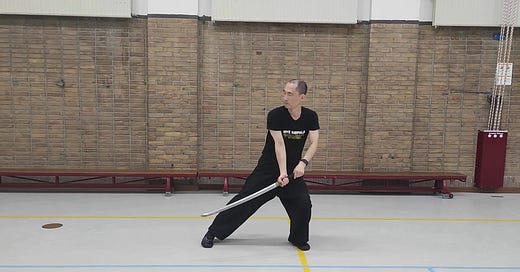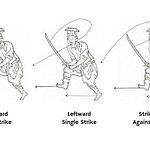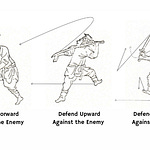Purpose and Context
This movement represents a strategic retrograde motion, where the practitioner responds to continuous forward pressure from the enemy—typically imagined as repeated spear thrusts. The retreat is not passive; it integrates active deflection, footwork, and counter potential at every stage.
Execution Breakdown
Starting Position:
Begin in a forward bow-arrow stance, having just performed a Rightward Single Strike.
Turn and Align:
From this position, turn your body backward, bringing your sword downward to your side in a controlled motion as you prepare to retreat.
Initiate the Retreat:
Turn your torso to the right as your right foot steps back into a backward bow-arrow stance. Simultaneously lift your sword upward to block an imagined high attack.
Block and Counter:
Next, turn your body to the left as your left foot steps back into the next backward bow-arrow stance. At the same time, lower your sword to block a low-line thrust or strike coming in.
Repeat with Rhythm:
Continue this pattern:
Turn your body to the right as your right foot steps back — block high.
Turn your body to the left as your left foot steps back — block low.
Repeat this sequence in a smooth, rhythmic flow until you have retreated back to your original starting position.
Technical Notes:
The stance transitions are key: maintain balance as you shift from a forward bow-arrow to a backward crouching stance, always aligning the body’s turning motion with the blocking action.
Visualize alternating attacks: a high-line strike followed by a low-line thrust, requiring precise timing and coordination.
The upward block is not merely a static defense but an active redirection, using the back of the blade to preserve its cutting edge for the next movement.
Synchronize footwork, body turning, and sword movements to maintain stability and continuous defense while retreating.
"Retreat is not defeat—it is the shape of survival, the arc of anticipation."
Training Tips
Practice with a mirror or partner using a staff or long weapon to simulate spear thrusts.
Focus on smooth weight transfer between steps—avoid bouncing or abrupt halts.
Keep the sword path consistent, with deflections and cuts flowing from the same rooted center.
This movement is not just about stepping back. It’s about maintaining your edge—literally and figuratively—under pressure. In both form and spirit, it prepares the practitioner to yield without surrender, retreat without losing initiative.
Remember to observe the fundamentals: proper warm-ups, basic stances, and cool-down routines. Videos demonstrating these essential practices are available here:
Enjoy the journey and feel free to ask me anything, comment below!













Share this post